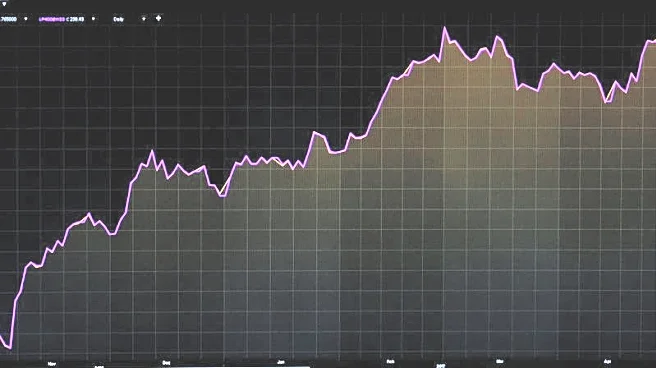What's Happening?
UBS has forecasted that the S&P 500 could rise to 7,500 by 2026, driven by approximately 14% earnings growth, with nearly half of that growth attributed to the technology sector. This prediction comes despite recent concerns over high valuations in the artificial
intelligence trade, which have pressured the market. The S&P 500 has already increased by over 15% this year, and key AI stocks such as Nvidia and Palantir Technologies have seen significant gains, with Nvidia rising more than 4% and Palantir over 7%. Broadcom and Oracle also experienced boosts in their stock prices. UBS's global head of economics and strategy research, Arend Kapteyn, noted that while the market could face a small negative impact due to valuation concerns, the overall outlook remains positive. Kapteyn anticipates a broadening and strengthening of growth from the second quarter of 2026, following a temporary slowdown caused by President Trump's tariffs.
Why It's Important?
The forecast by UBS highlights the significant role of technology and AI stocks in driving market growth, underscoring the sector's influence on the broader economy. The anticipated rise in the S&P 500 suggests optimism among investors regarding the resilience and potential of tech-driven earnings. However, the prediction also acknowledges potential challenges, such as tariffs impacting prices and exports, which could create a 'soft patch' in the global economy. The focus on high-quality stocks outperforming suggests a shift in investment strategies, with investors potentially seeking stability amid economic uncertainties. This development could have implications for U.S. economic policy and investor confidence, influencing decisions in both domestic and international markets.
What's Next?
As the market anticipates the end of the U.S. government shutdown, investors are hopeful for a resolution that could further stabilize economic conditions. The forecast suggests a consolidation phase where high-quality stocks may outperform, followed by a broadening rally into lower-quality cyclicals from late Q1 2026. This shift could lead to diversified investment strategies and adjustments in portfolio allocations. Additionally, the impact of tariffs on the U.S. economy and global exports will be closely monitored, potentially prompting policy responses or negotiations to mitigate adverse effects. Stakeholders, including businesses and policymakers, may need to adapt to these evolving economic dynamics.
Beyond the Headlines
The emphasis on AI and technology stocks as key drivers of market growth reflects broader trends in digital transformation and innovation. This focus may accelerate investments in AI technologies and related sectors, influencing job creation, skill development, and industry competitiveness. Ethical considerations around AI deployment, data privacy, and regulatory frameworks could become more prominent as these technologies gain traction. Long-term shifts in consumer behavior and business models may emerge, driven by technological advancements and changing economic landscapes.














